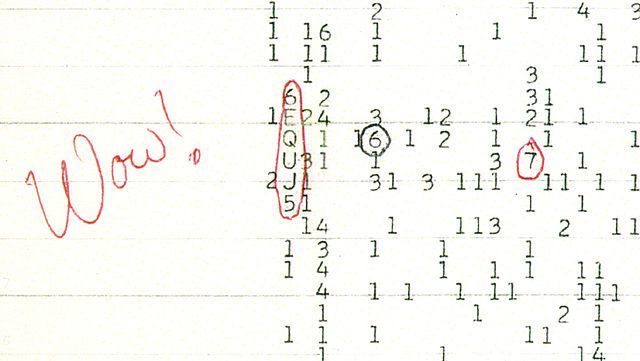What Do Scientists Do When They Think They Might Have Intercepted Alien Signals?
Inexplicable data can pose a particular problem.
Imagine that you’re an astronomer, working in your lab, day in and day out, analyzing signals from space. Waves of energy pass through, you measure them, you calculate what they mean—what stars, asteroids, quasars, black holes, and planets are doing very, very far away from here. One day, a strange signal registers on your instruments. You check that it’s not an equipment error. You start running through possible explanations, all the obvious ones and the less obvious ones. Nothing fits.
You know the signal is not coming from this planet. Maybe you start thinking that one possible explanation, as unlikely as it may be, is that you’ve come across a sign of extraterrestrial intelligence.
This happens from time to time, even to scientists who had no intention of searching for alien life. Nikola Tesla thought a signal that his receivers picked up on a summer night in 1899 may have come from Mars. The scientists who discovered pulsars considered, for a bit, that the regular pulses they were detecting might be the work of “little green men.” Most recently, a group of scientists suggested that unusual and unexplained fluctuations in the light of a star looked similar to what one would expect to see if alien-built megastructures were circling it.
Weird signals raise a particular problem: what happens when you find data coming from the vastness of space which has no apparent explanation—or for which one possible explanation is an unbelievable one? Why is it so hard to count out aliens once they’ve been invoked.

Tesla’s lab in Colorado Springs contained some of the most sensitive receivers of electric signals that had been invented by 1899, meant for his work on wireless electrical transmissions. The receivers could sense changes within a 1,100 mile radius; Tesla had used them to predict lightning storms.
He knew what the receivers’ normal background noise sounded like, and what he heard on that night in 1899 was a different pattern. It was “taking place periodically, and with such a clear suggestion of number and order,” he’d write later. It was like they were counting. One. Then two. Three. Four.
Tesla heard the signals more than once, in that lab, and, as a good scientist should, he started considering possible causes. Could it be the sun? The Aurora borealis? The currents of the earth? He was familiar with those electrical disturbances. This was not the same.
“I was as sure as I could be of any fact that these variations were due to none of these causes,” he’d write. “The feeling is constantly growing on me that I had been the first to hear the greeting on one planet to another. A purpose was behind those electric signals.”
In 1899, it still seemed possible that there might be life on nearby planets, and that’s where Tesla hypothesized the signals were coming from. He thought that if he could send a message back, perhaps he would get a response—proof that his feeling was correct.
But one of the difficulties of pinning strange signals on aliens is that there’s plenty of other non-intelligent (if amazing) stuff out there we don’t know about. We keep discovering new space phenomena.
In the 1990s, James and Kenneth Corum, two members of New York’s Tesla Society with electrical engineering experience, put forward a new hypothesis for what Tesla heard—electric pulses from Jupiter, created by its interaction with one of its moons, Io. These had not yet been discovered in Tesla’s time, but almost a century later, they were a well-established phenomenon.
To test their theory, the Corum brothers reconstructed Tesla’s receivers from 1899, and under the right conditions, they did pick up signals coming from Jupiter.
“When you listen to kilometric signals from Jupiter with one of Tesla’s Colorado Springs receivers, you occasionally hear a ‘Beep…Beep-Beep…Beep-Beep-Beep,” they wrote. It was like Tesla had written—1, 2, 3.
This sort of historical re-enactment isn’t enough to establish, without a doubt, that Tesla was picking up signals from a planet 390 million miles away. (Even the Corums acknowledge that it’s not enough to “convince the skeptical.”)
But they did hear something like the same signal again. To be able to say anything definitive about an anomalous signal, this is the first requirement. And it can be harder than it seems. One of the most famous unexplained space signals, the Wow signal, appeared only once, and never again.

The scientists who found the Wow signal were actually looking for signs of extraterrestrial intelligence. They had a radio telescope that had been surveying the sky for celestial objects like quasars, before the project lost its funding and most of the people working on it lost their jobs. The unemployed telescope was put to work to search for signals from extraterrestrial intelligence, by scanning narrowband frequencies, where only man-made technologies were known to operate.
One day, Jerry Ehman, a scientist working on the project, sat down to go through the data, which showed what the telescope had registered beyond background noise. The print-out used letters if the telescope ever registered more than 9 times the normal noise—A was 10 times background, B, 11 times, and so on. Usually, the print-outs were a field of 1s and 2s, but this time, there was a stand-out series: 6EQUJ5—a peak of more than 30 times above background noise.
Ehman circled the sequence and wrote “Wow!” on the sheet.
Ehman and his colleagues were able to rule out many possible causes of the signal. It was not an equipment error, a military experiment, a satellite, or a supernova. In a couple of key ways, it looked a lot like what one might expect a signal from an intelligent civilization to look like.
That didn’t necessarily mean it was a signal from an extraterrestrial group. “Oh, I want it to be,” Ehman once said—but there was no way to prove it, and no more data to work with. An amateur astronomer, not part of the original team, spent years trying to find the WoW signal again, traveling the world to use powerful telescopes and track down the best observation windows. But, he finally admitted, the signal “has proven elusive.”
Another scientist, Antonio Paris, thinks he may be able to solve the puzzle within the next year. He believes the signal may have come from a comet, which passes only intermittently and would explain why the signal had never been found again—no one was looking at the right time. But the comet is coming by again in 2017, and Paris intends to be pointing a radio telescope at it. He has one that used to belong to NASA, but was decommissioned and sold at auction. An engineer with a radio astronomy jones bought it for less than $1,000 and had been using it as a hobby. He offered Paris its use for the next three years: testing will start in July, so that when the comet comes back in January 2017, they’ll be ready for it.
What they find, though, may not be the Wow signal. “It’s like dropping a penny in the ocean and coming back 34 years later to look for that penny,” Paris says.
This is why it can be hard to explain strange signals—and why, at the same time, it’s hard to rule out aliens. Space is vast, vast, vast. Anomalous signals pop up all the time on our observational equipment, and often are just dismissed as blips. Even if they are strange, with just one data point, it’s hard to conclude much of anything.
On the other hand, space is so big and our capacity to observe it so limited that it’s possible that there are other data points out there and we just happen not to be looking at the right time. One theory about the Wow signal holds that if it did come from aliens, perhaps the signal swept by us, like a beacon in the night, and will be back eventually—we just can’t predict when.

The work that Paris is doing is not the sort that NASA and the National Science Foundation give grant funding for. There’s only so much money for astronomy research, and very little of it goes to projects that focus on SETI, the search for extraterrestrial intelligence. There are only so many hours each year that the world’s telescope can be measuring signals from the sky, and there’s fierce competition among scientists to claim a few of those hours to point a powerful telescope at the part of the universe they’re most interested in.
In SETI research, there’s no guarantee that if you point a telescope at the part of the sky you’re interested in that you’ll find anything at all. We have no idea exactly what we’re looking for—only guesses about what the most promising directions to look in might be, or how aliens might try to make themselves known.
But there is logic behind our best guesses of how to look for aliens. In a 2005 paper, one SETI scientist pointed out that if an alien civilization had created star-orbiting megastructures, Kepler, the telescope that’s been searching for planets, would see them. For any object the size of Jupiter or larger, Kepler could tell, too, if the orbiting objects were circular or not. Alien megastructures probably wouldn’t be circular (Death Stars excluded), so we should pay attention if any non-circular objects showed up.
They did. Jason Wright, an astronomer at Penn State, noticed that, in fact, Kepler had found non-circular objects orbiting stars, as predicted. There was a good explanation for all the ones he knew of, though, until Tabetha Boyajian, an astronomer at Yale University, told him about the strange flux of light in the star she was studying. The pattern was originally flagged by citizen scientists, but when Boyajian started looking for an explanation of the star’s strange behavior, she couldn’t find an obvious one.
“The observations didn’t fall into any clear category,” she says. She started talking to other scientists, testing out ideas, until, finally, she had convinced herself. “This is truly something that is unique,” she says.
Boyajian had published a paper on the star’s strange light pattern, and Wright was working the alien megastructure possibility in a paper of his own, when a reporter at the Atlantic wrote about their research. All of sudden, science writers were reporting that they might have discovered alien megastructures.
Boyajian raised money on Kickstarter to buy telescope time to continue observing the star and its weird flux. The explanation is probably not alien megastructures circling it, she says. “Nature has a much better imagination than we do. You don’t want to give up on physics,” explains Boyajian. “It is probably something natural that we just haven’t thought of yet.”
As they try to track down that natural source, though, they’re doing much of the same work they’d do to track down an intelligent alien source. For Wright, the mystery of the star and the source of its fluctuation is a fascinating science puzzle—with the bonus that there’s a SETI angle. “It doesn’t take much to be interesting from a SETI perspective,” he says. “There aren’t a lot of leads.”
This one is very, very unlikely to lead us to an extraterrestrial civilization. Until scientists get another good look at that star, though, it is still possible, in the most conservative sense, that aliens are responsible for its strange behavior. But probably there’s some other explanation.





















Follow us on Twitter to get the latest on the world's hidden wonders.
Like us on Facebook to get the latest on the world's hidden wonders.
Follow us on Twitter Like us on Facebook